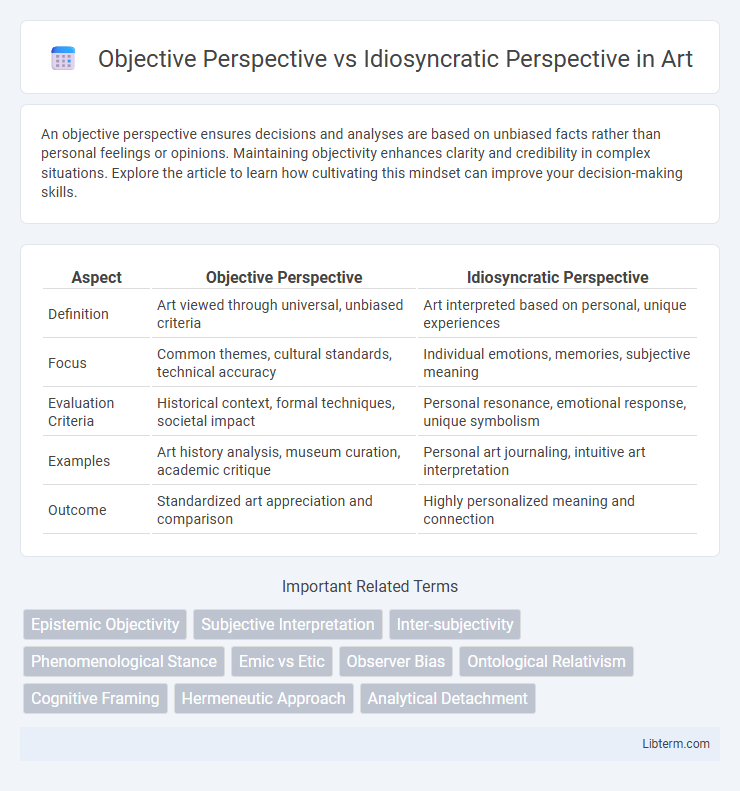An objective perspective ensures decisions and analyses are based on unbiased facts rather than personal feelings or opinions. Maintaining objectivity enhances clarity and credibility in complex situations. Explore the article to learn how cultivating this mindset can improve your decision-making skills.
Table of Comparison
| Aspect | Objective Perspective | Idiosyncratic Perspective |
|---|---|---|
| Definition | Art viewed through universal, unbiased criteria | Art interpreted based on personal, unique experiences |
| Focus | Common themes, cultural standards, technical accuracy | Individual emotions, memories, subjective meaning |
| Evaluation Criteria | Historical context, formal techniques, societal impact | Personal resonance, emotional response, unique symbolism |
| Examples | Art history analysis, museum curation, academic critique | Personal art journaling, intuitive art interpretation |
| Outcome | Standardized art appreciation and comparison | Highly personalized meaning and connection |
Understanding Objective Perspective
Understanding objective perspective involves analyzing facts and evidence without personal bias, ensuring a neutral and impartial viewpoint. This approach prioritizes verifiable data and widely accepted standards over individual feelings or subjective interpretations. Emphasizing objectivity aids in clearer decision-making and fosters credibility in assessments across various disciplines.
Defining Idiosyncratic Perspective
Idiosyncratic perspective refers to an individual's unique way of interpreting experiences and information based on personal beliefs, emotions, and cognitive biases. Unlike the objective perspective, which strives for neutrality and universal validity, the idiosyncratic perspective is inherently subjective and shaped by personal history and context. This perspective plays a crucial role in shaping individual creativity, decision-making, and interpersonal understanding.
Key Differences Between Objective and Idiosyncratic Views
Objective perspective is grounded in factual, unbiased observation and relies on universally accepted evidence, ensuring consistency and replicability across different observers. Idiosyncratic perspective is shaped by personal experiences, emotions, and unique cognitive biases, leading to subjective interpretations that vary widely between individuals. Key differences include the reliance on empirical data for objectivity versus the individual's internal framework guiding idiosyncratic views, impacting the accuracy and generalizability of conclusions.
The Role of Bias in Perception
Bias in perception significantly influences the distinction between objective and idiosyncratic perspectives, where objective perspectives strive for impartiality through evidence-based analysis. Idiosyncratic perspectives, however, are shaped by personal experiences, emotions, and cognitive biases that filter and distort information uniquely for each individual. Understanding the role of confirmation bias, anchoring, and cultural influences is essential to recognizing how subjective viewpoints diverge from objective interpretations.
Advantages of Objective Analysis
Objective analysis offers clear advantages by relying on unbiased data and verifiable facts, which enhance decision-making accuracy and reliability. It reduces personal biases and emotional influences, ensuring consistent evaluations across varying situations and individuals. This approach facilitates transparent communication and fosters trust among stakeholders by grounding conclusions in evidence rather than subjective interpretation.
Strengths of Idiosyncratic Interpretation
Idiosyncratic interpretation offers unique insights by embracing individual experiences and personal context, which fosters creativity and innovation often overlooked by objective perspectives. This approach enhances emotional resonance and depth of understanding by valuing subjective nuances and diverse viewpoints. The strength of idiosyncratic interpretation lies in its ability to challenge conventional norms and generate novel ideas tailored to specific cultural or psychological frameworks.
Applications in Decision Making
Objective perspective in decision making relies on unbiased data, empirical evidence, and standardized metrics to ensure consistency and rationality in outcomes. Idiosyncratic perspective incorporates individual experiences, intuition, and subjective judgment, allowing for flexibility and creativity in complex or ambiguous situations. Combining both perspectives enhances decision quality by balancing factual accuracy with personal insight and contextual understanding.
Challenges in Maintaining Objectivity
Maintaining objectivity presents significant challenges due to inherent human biases and personal experiences shaping the idiosyncratic perspective. Cognitive biases such as confirmation bias and selective perception complicate efforts to evaluate information impartially. Overcoming these obstacles requires deliberate strategies and awareness to ensure balanced and unbiased analysis.
Balancing Objectivity and Subjectivity
Balancing objectivity and subjectivity requires recognizing the value of both the objective perspective, which relies on unbiased facts and universally accepted criteria, and the idiosyncratic perspective, which incorporates personal experiences and individual interpretations. Maintaining this balance enhances critical thinking by integrating empirical evidence with unique viewpoints, fostering a more comprehensive understanding of complex issues. Effective decision-making involves blending measurable data with nuanced insights shaped by cultural, emotional, and psychological factors.
Impact on Communication and Understanding
Objective perspective fosters clear communication by emphasizing facts and shared realities, reducing misunderstandings and bias in information exchange. Idiosyncratic perspective introduces personal experiences and interpretations, enriching dialogue but potentially causing ambiguity or misinterpretation if not contextualized. Effective communication balances both views, enhancing mutual understanding by aligning factual accuracy with individual empathy.
Objective Perspective Infographic

 libterm.com
libterm.com